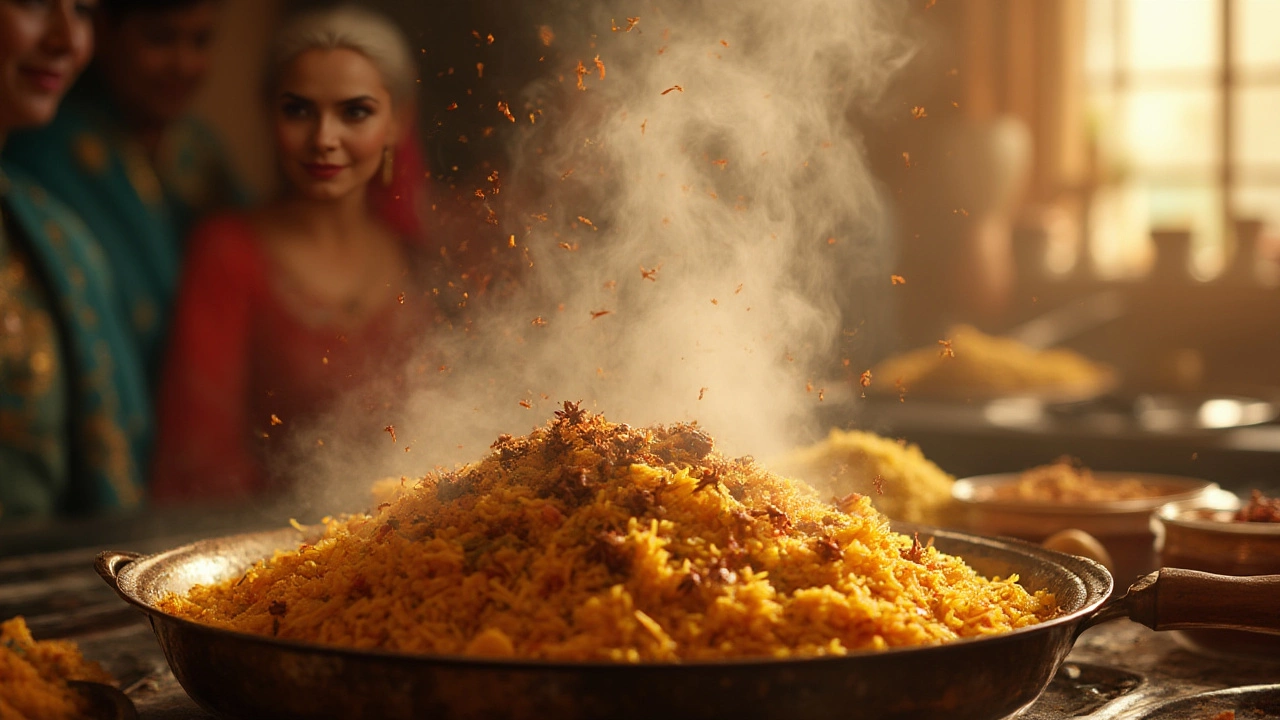Ever paused mid-bite, eyes closed, letting the scent of a good biryani wash over you? That aroma isn’t just a side note. For most biryani lovers, the fragrance is everything. It teases your appetite well before you spot the dish. If you’ve wondered what creates that magic, you’re not alone. The quest for aromatic biryani has inspired endless debates in home kitchens and high-end restaurants alike. Some folks even say you can judge biryani by its scent alone, without seeing a single grain of rice. So, what’s pumping out those mouthwatering waves of fragrance?
The Heart of the Aroma: Spices and Their Roles
Let’s cut straight to the chase—spices are the rock stars of biryani aroma. And not just any spices, but a symphony of whole and ground spices working together. Start with cardamom—especially green and black pods. Just one split open and tossed into hot ghee fills the air with sweet, piney notes. Then there’s cinnamon—nothing beats its gentle warmth. Don’t forget cloves: they pop with a heady, powerful scent that lingers, giving biryani its bold, inviting edge.
Star anise adds an almost licorice-sweet undertone, while bay leaves serve up earthiness few other leaves can. Some cooks sneak in mace blades (the lacy covering of nutmeg), which ramps up that nutty, slightly peppery aroma. These whole spices work best when added early—often while frying onions—letting hot oil extract their fragrant oils.
Now for the ground players: coriander, cumin, and a touch of garam masala. Each brings its own twist, but the trick is moderation. Too much of one? It drowns out the others and overpowers the signature biryani scent.
Here’s an odd but true fact: a study by the Indian Institute of Spices Research found that freshly ground spices, right before cooking, can double the aroma intensity compared to pre-ground ones. That’s why old-school chefs always crush cardamom and cumin moments before using them. If you’re chasing a truly wow-worthy biryani, invest in a little spice grinder or even use a simple mortar and pestle.
But let’s not downplay a vital supporting act: the timing. Timing dictates whether your spices just flavor the food or make the whole house smell like a royal feast. Add them when the oil is hot, never cold, and let them sizzle just until fragrant—say, 40 seconds. Go longer, and bitterness can sneak in, especially with cloves and cinnamon. There’s a finesse here that comes with practice: too short, and the potential aroma is left uncaptured; too long, and you risk burning, which mutes everything.
The Secret Power of Basmati Rice
If you think biryani’s aromatic power comes from spices alone, wait till you hear about rice. Specifically, aged basmati rice is the biryani MVP. Ever noticed that regular rice just doesn’t have the same effect? That’s because basmati is unique—it packs natural aroma compounds not found in your everyday grains.
The hero compound here is called 2-acetyl-1-pyrroline (2-AP), which gives off that popcorn-like, nutty scent. Basmati, especially when aged for over a year, contains much more 2-AP than cheaper varieties. Some classic Indian cooking books recommend rice that’s at least two years old for festival biryanis. The extra aging dries it further, so the grains stay long, fluffy, and each one carries those precious flavor molecules.
Want a quick trick? Give your basmati a sniff before you soak it. The best rice has a faint floral scent, almost jasmine-like. If your rice doesn’t have that aroma, there’s not much a cook can do to compensate. This is why chefs in Hyderabad or Lucknow guard their rice suppliers like prized secrets.
The other piece of the puzzle is how you prep the rice. Soaking it for at least 30 minutes loosens up the grains, making them ready to absorb aromatics from spices, stock, or saffron. But careful—you want to parboil the rice, not fully cook it, before layering. Overcooked rice loses shape and aroma both. And never, ever skip the rinse. Washing basmati removes excess starch, which can dull the flavor and make things gummy rather than aromatic.
Lastly, cooking rice with just a little salt and a touch of whole spices (maybe a bay leaf or stick of cinnamon) adds subtle background notes even before you start assembling the biryani. A chef in Kolkata told me she always tosses in a handful of soaked rose petals during the rice boil, and that whisper of floral scent makes her biryani stand out at family gatherings.

Infused Accents: Saffron, Herbs, and Topper Techniques
Here comes the true fancy stuff: saffron and herbs. Saffron isn’t just for color—it’s one of biryani’s fragrance superchargers. Genuine Kashmiri saffron, when steeped in warm milk, releases a honeyed, earthy bouquet unlike anything else. Even a few strands, evenly sprinkled over the rice, transform the whole dish. Don’t be stingy, but also, don't be fooled by fake saffron—real saffron will gently color the milk orange-copper; if it’s shocking yellow or instantly dark, it’s likely dyed.
Fresh herbs like mint and cilantro pack a punch too. The trick is not to cook them too much, or they’ll taste and smell muddy. Scattering torn mint and cilantro between the rice layers creates little pockets of herby, fresh intensity. Some people swear by a squeeze of lime right before serving; others add a touch of rose water or kewra (pandan essence) on the top layer for extra floral oomph. Use these essences with a light hand—a few drops go a long way. In upscale hotels, chefs often dab a bit of ghee or butter mixed with cardamom on top right before sealing the pot, making the rising steam even richer.
There’s a lesser-known trick borrowed from Persian cooking: layering caramelized onions, also called birista. Fried onions sprinkled between rice layers give off a warm, deep sweetness that mingles with the other scents. Don’t rush this part—onions cooked slow and steady, until browned but not burned, are packed with aroma. Some folks even crank up the effect by using the oil from frying the onions as their base—the flavor boost is real.
When you put it all together, you get a layered fragrance. Think: base notes from spices, mid-notes from rice, and top notes from saffron, herbs, and those incredible crispy onions. The real magic is the dum or steam cooking: sealing the pot with dough or a tight lid and letting everything sweat together. The aromas go wild, bouncing around in the pot and soaking back into the ingredients. Open the lid, and the burst of scent fills the room, usually drawing in anyone within nose-shot.
Common Mistakes and Smart Tips for Aroma Perfection
A great aroma isn’t just about the ingredients—it also comes down to technique. One of the biggest missteps is skipping the layering or rushing the sealing process. Biryani isn’t stir-fried: it’s carefully pieced together so every bite gets a mix of flavors and scents that’s built up, not blended down.
Another pitfall: using poor oil. Neutral oils work, but ghee or high-quality butter truly elevates the aroma. Ghee, made from slowly simmered, clarified butter, has its own nutty, rich flavor—all of which heighten the dish’s fragrance when heated with spices.
Too much water is another killer. Rice needs just enough moisture to finish cooking on dum, but not so much that the steam dilutes the aroma. A little goes a long way. Plus, avoid overcrowding—if you pack the pot too tightly, steam can’t circulate and you won’t get that signature *dug-in* perfume.
One easy trick for boosting aroma is using a clay or heavy-bottomed vessel. Claypots hold and mellow heat, letting the biryani cook gently and curve around all the edges, while preventing burning or hot spots. Cast iron does this too, but with a bit more heft.
Let’s talk serving: don’t immediately open the biryani when it’s done. Give it a solid 5-10 minutes of resting time, sealed, off the heat. This lets the steam settle and the flavors (and fragrances!) to settle back into the grains. When you do crack it open, do it tableside if you can—the first puff is always the most intoxicating.
Keep in mind, not all biryanis smell the same. A Hyderabadi biryani will use richer masala and fried onions, while a Lucknowi version might have a subtler, slightly floral profile. Even South Indian biryanis can pack a punch of curry leaves and coconut, totally changing the scent game. Consider what you’re craving and experiment—no two batches need be identical.
There’s real science behind why biryani’s aroma is so powerful. It comes down to how heat unlocks and marries volatile oils from spices, aroma compounds from rice, and fat-soluble flavor molecules from ghee or butter. This makes biryani’s aroma “fat-rich”—it literally lingers on your lips. The next time you make or eat biryani, pay attention to which scents hit you first. Is it the high floral note from saffron? The deep undertone of caramelized onions? The sharpness of freshly cracked cardamom? Recognizing these will not only make you a better cook, but also help you appreciate the ritual and artistry baked into every batch of biryani. After all, for so many of us, biryani aroma is much more than just smell. It’s a memory in every breath.
